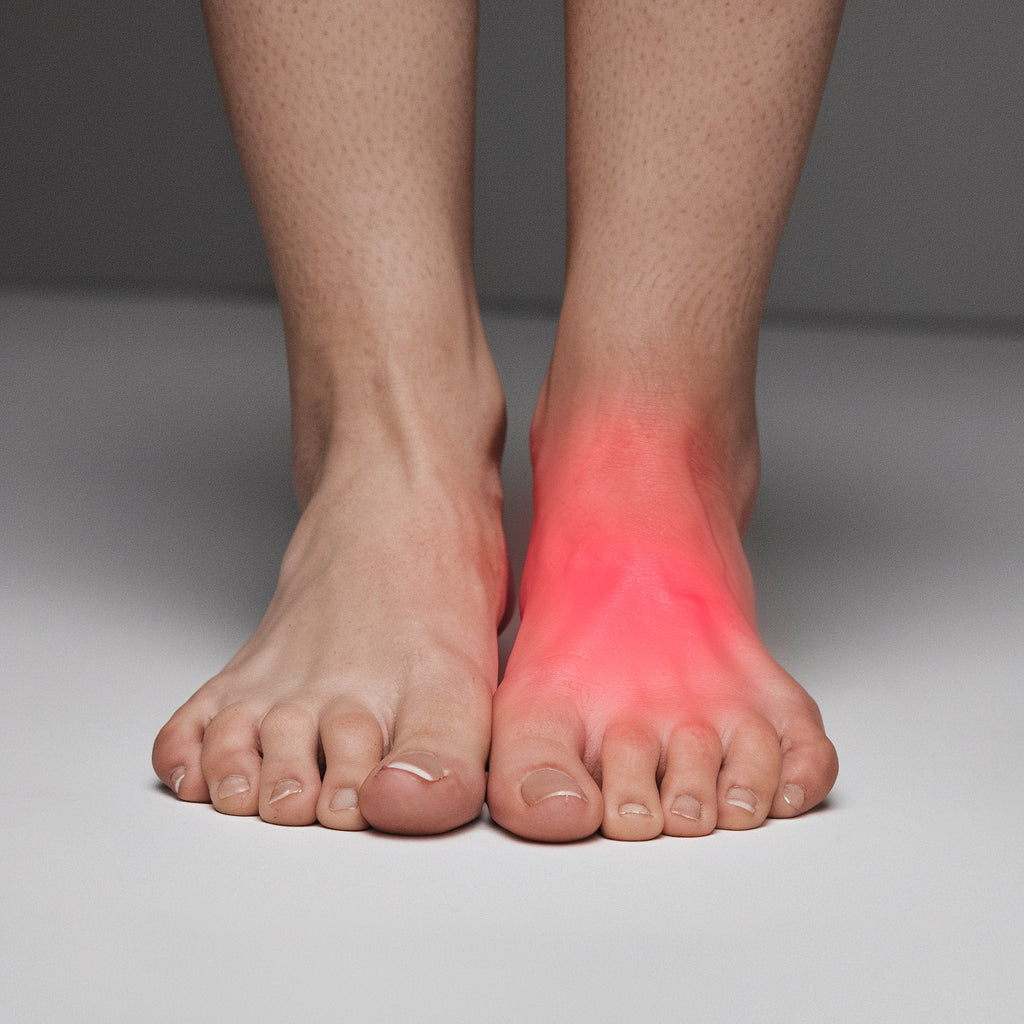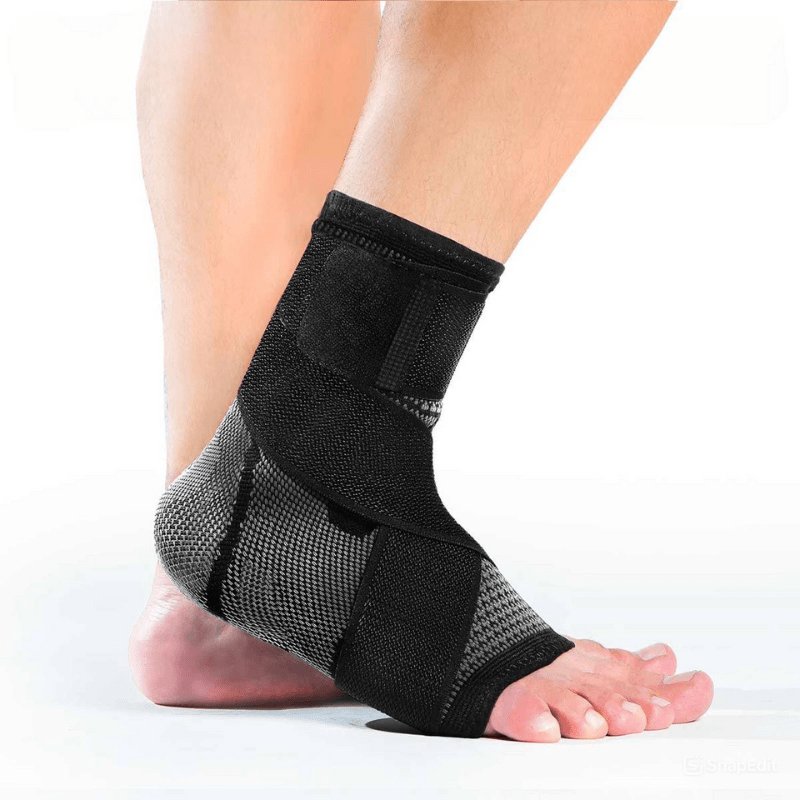Gout in the Foot: Symptoms, Causes, and Treatment

Gout in the foot is a painful form of arthritis caused by the accumulation of uric acid crystals in the ankle joint. Gout is the most common inflammatory joint disease and often affects the foot, especially the big toe. This article reviews the most common symptoms, causes, and treatment options for gout in the foot.
What is gout in the foot?
Gout in the foot is an inflammatory joint disease that most often affects the base of the big toe, sometimes called "port wine toe," but can also affect other joints in the foot. Gout is an inflammation caused by a buildup of uric acid crystals (urate) that lead to inflammation and pain. Gout often comes in attacks that can be very painful.
Gout can also develop into chronic gout if left untreated. Chronic tophaceous gout is characterized by permanent changes in the joints and the formation of tophi, which are collections of uric acid crystals under the skin. Gout can affect any joint, but symptoms of gout usually appear first in the foot and then travel down to the foot from other joints.
Symptoms of gout in the foot
Common symptoms of gout in the foot include:
- Sudden and intense pain in the ankle, especially at night
- Swelling and redness around the affected joint
- Tenderness to the touch, skin may look shiny and tight
- Heat increase in the affected area
- Stiffness and limited mobility in the foot
- In recurrent gout or untreated gout, tophi can form under the skin.
- Gout in the big toe is particularly common and can be extremely painful.
- Gout in the toe can make it impossible to wear shoes during an attack
In acute gout, symptoms often come on very suddenly, often overnight, and can be extremely intense. Gout is a painful condition that is often described as one of the most painful forms of arthritis. It is important to be able to distinguish the symptoms from other conditions, such as burning feet .
Causes of gout in the foot
Gout is caused by elevated levels of uric acid in the blood, a condition called hyperuricemia. Uric acid is a byproduct formed when the body breaks down purines. Factors that can contribute to this and increase the risk of gout include:
- Genetic factors – primary gout often has a hereditary component
- Diet rich in purines (e.g. red meat, seafood, organ meats)
- Obesity – increases the production of uric acid
- High alcohol consumption, especially beer which is rich in purines
- Certain medications such as diuretics and low-dose aspirin
- The kidneys may have difficulty excreting uric acid.
- High blood pressure and other metabolic conditions increase the risk
- Rapid weight loss can temporarily increase uric acid in the blood
When the level of uric acid in the blood increases, uric acid crystals can form in the joints, triggering the inflammation and pain typical of gout. The risk of developing gout increases with age and is more common in men than in women before menopause. Similar metabolic conditions can also cause osteoarthritis in the foot .
Diagnosis and treatment of gout in the foot
Gout in the foot occurs when uric acid crystals build up in the joints, often in the big toe. This leads to sudden pain, swelling, redness and warmth in the affected area. The condition can occur in attacks and cause significant discomfort. Treating gout effectively requires a correct diagnosis and a combination of medical and lifestyle measures.
Physical examination
Diagnosis usually begins with a clinical examination, where the doctor assesses swelling, warmth, and pain in the joint. A careful physical examination may indicate gout, especially if there is recurrent inflammation in the foot. Treatment often includes anti-inflammatory medications to reduce pain and swelling.
Blood test for uric acid levels
A blood test is used to measure the amount of uric acid in the blood. Elevated levels support the diagnosis but are not conclusive on their own, as some patients may have gout despite normal levels. In acute attacks, colchicine can be used to relieve pain and reduce the duration of the attack.
Synovial fluid test to see urate crystals
To confirm gout, a sample of synovial fluid is sometimes taken and examined under a microscope for urate crystals. If crystals are found, the diagnosis is confirmed. Treatment is then directed at medications that lower uric acid levels in the body, thereby reducing the risk of new attacks.
Ultrasound or X-ray
Imaging tests such as ultrasound or X-rays are used to detect signs of inflammation or crystal formation in the joints. These tests can also rule out other causes of joint pain. Lifestyle changes, such as dietary changes, weight control, and reduced alcohol intake, are often recommended in conjunction with this.

How the Foot Support and Termoreliever™ can help with gout in the foot
The Foot Support and Termoreliever™ can be effective aids in managing gout in the foot:
- The Foot Support provides relief and support to the affected joint, which can reduce pain.
- Termoreliever™ offers heat therapy that can relieve pain and stiffness in the affected joint
- The combination can improve comfort during daily activities and relieve discomfort
- Can be used as a complement to medical treatment to manage symptoms
- Particularly valuable during the recovery phase after an acute attack
These aids help relieve discomfort and can help people with gout maintain mobility between attacks. They can also help prevent further damage to the affected joint by providing the right support.
Conclusion
Gout in the foot is a painful condition that requires prompt diagnosis and treatment. By combining medical treatment, lifestyle changes, and supportive devices such as the FootSupport and Termoreliever™, many people can effectively manage their symptoms and improve their quality of life.
Preventive measures against gout are important to reduce the risk of gout and recurrent attacks. If you suspect you have gout, it is important to seek medical attention for proper diagnosis and treatment. With proper management, most cases of gout can be effectively controlled. It is also important to rule out other causes of foot pain, such aspain under the foot .
Frequently Asked Questions (FAQ)
Can gout in the foot be completely cured?
Gout cannot be cured completely, but with the right treatment, symptoms can be effectively controlled. Preventive treatment can dramatically reduce the frequency and intensity of attacks, and many people with gout live completely normal lives.
How long does a gout attack in the foot last?
An untreated gout attack can last for days to weeks, but with treatment it can be significantly shortened. Most attacks resolve within 3-10 days with proper treatment. The sooner treatment is started, the shorter the attack usually is.
Can FotSupporten and Termoreliever™ replace medical treatment for gout?
No, they should be used as a complement to, not a substitute for, medical treatment. While these aids can offer significant relief, medical treatment is needed to address the underlying cause - the elevated uric acid levels.
What home remedies can relieve gout in the foot?
Drinking plenty of water, resting the foot, and applying ice can help. Some people also find relief by keeping the affected foot elevated. However, always consult a doctor for proper treatment, especially for acute attacks.
How can I prevent gout attacks in the foot?
By avoiding purine-rich foods, limiting alcohol intake, maintaining a healthy weight, and drinking plenty of water, you can reduce your risk of gout attacks. Regular checks of uric acid levels and following your doctor's recommendations for preventive medications are also important for people who have already had gout.

